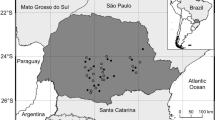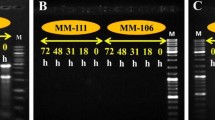Abstract
Plasmodiophora brassicae is a biotrophic pathogen and causes clubroot of cruciferous crops. Our study was conducted to find genetic markers for differentiating the pathotype 7. Three molecular markers were obtained, PBRA_000303 presented exclusively in pathotype 7 among the tested pathotypes (P2, P4, P5, P7, P9, P10, P11), PBRA_006533 and PBRA_009559 presented in pathotype 7 and a genotype of pathotype 4 (P4*). The similar results were obtained by clustering analysis based on SRAP and the small subunit (SSU) of P. brassicae rDNA sequence: P7 and P4* were clustered a clade, most of P4 was clustered into another clade. A 380 bp fragment in SSU was existent in P7 and P4* but scarce in most P4. Virulence analysis discovered that pathotype 7 had similar pathogenicity to P4* but lower pathogenicity than most pathotype 4. Although the genetic information had similarity among different pathotype, it is noteworthy that this study is the first to establish a specific molecular identification system for pathotype 7 by PCR analysis, and provides a promising tool to conveniently monitor the distribution of P7.






Similar content being viewed by others
References
Chai, A. L., Xie, X. W., Shi, Y. X., & Li, B. J. (2014). Research status of clubroot (Plasmodiophora brassicae) on cruciferous crops in China. Canadian Journal of Plant Pathology, 36, 142–153.
Diederichsen, E., Frauen, M., Linders, E. G. A., Hatakeyama, K., & Hirai, M. (2009). Status and perspectives of clubroot resistance breeding in crucifer crops. Journal of Plant Growth Regulation, 28, 265–281.
Dixon, G. R. (2009). The occurrence and economic impact of Plasmodiophora brassicae and clubroot disease. Journal of Plant Growth Regulation, 28, 194–202.
Donald, C., & Porter, I. (2009). Integrated control of clubroot. Plant Growth Regulation, 28, 289–303.
Felsenstein, J. (1985). Confidence limits on phylogenies: An approach using the bootstrap. Evolution, 39, 783–791.
Gossen, B. D., Strelkov, S. E., Manolii, V. P., Rennie, D. C., Cao, T., & Hwang, S. F. (2015). Spread of Plasmodiophora brassicae on canola in Canada, 2003–2014: Old pathogen, new home. Canadian Journal of Plant Pathology, 37, 403–413.
Hirai, M. (2006). Genetic analysis of clubroot resistance in brassica crops. Breeding Science, 56, 223–229.
Ji, R., Zhao, L., Xing, M., Shen, X., Bi, Q., Peng, S., & Feng, H. (2014). Infection of Plasmodiophora brassicae in Chinese cabbage. Genetics and Molecular Research, 13, 10976–10982.
Kimura, M., & Crow, J. F. (1964). The number of alleles that can be maintained in a finite population. Genetics, 49, 725–738.
Kuginuki, Y., Yoshikawa, H., & Hirai, M. (1999). Variation in virulence of Plasmodiophora brassicae in Japan tested with clubroot-resistant cultivars of Chinese cabbage (Brassicarapa L. ssp. pekinensis). European Journal of Plant Pathology, 105, 327–332.
Kumar, S., Stecher, G., & Tamura, K. (2016). MEGA7: Molecular evolutionary genetics analysis version 7.0 for bigger datasets. Molecular Biology and Evolution, 33, 1870–1874.
Laila, R., Robin, A. H. K., Yang, K., Choi, G. J., Jong-In, P., & Nou, I. (2017). Reply to the Letter to the Editor by A. Schwelm and S. Neuhauser: “Detection of Ribosomal DNA Sequence Polymorphisms in the Protist Plasmodiophora brassicae for the Identification of Geographical Isolates”. International Journal of Molecular Sciences, 18, 1455. https://doi.org/10.3390/ijms18071455.
Lewontin, R. C. (1972). The appointment of human diversity. Evolutionary Biology, 6, 381–398.
Li, G., & Quiros, C. F. (2001). Sequence-related amplified polymorphism (SRAP), a new marker system based on a simple PCR reaction: Its application to mapping and gene tagging in Brassica. Theoretical and Applied Genetics, 103, 455–461.
Liu, F., Zhang, L. H., & Ji, G. H. (2013). Identification of physiological race of Plasmodiophora brassicae in Yunnan and Tibet. China Vegetable., 20, 77–81.
Manzanares-Dauleux, M. J., Barret, P., & Thomas, G. (2000). Development of a pathotype specific SCAR marker in Plasmodiophora brassicae. European Journal of Plant Pathology, 106, 781–787.
Mortazavi, A., Williams, B. A., Mccue, K., Schaeffer, L., & Wold, B. (2008). Mapping and quantifying mammalian transcriptomes by RNA-Seq. Nature Methods, 5, 621–628.
Niwa, R., Kawahara, A., Murakami, H., Tanaka, S., & Ezawa, T. (2011). Complete structure of nuclear rDNA of the obligate plant parasite Plasmodiophora brassicae: Intraspecific polymorphisms in the exon and group I intron of the large subunit rDNA. Protist, 162, 423–434.
Rohlf FJ, (2000). NTSYS-pc. Numerical taxonomy and multivariate analysis system, version 2.10e. Applied biostatistics Inc, New York.
Saitou, N., & Nei, M. (1987). The neighbor-joining method: A new method for reconstructing phylogenetic trees. Molecular Biology and Evolution, 4, 406–425.
Schwelm, A., Berney, C., Dixelius, C., Bass, D., & Neuhauser, S. (2016). The large subunit rDNA sequence of Plasmodiophora brassicae does not contain intra-species polymorphism. Protist., 167, 544–554.
Sharma, K., Gossen, B. D., & McDonald, M. R. (2011). Effect of temperature on cortical infection by Plasmodiophora brassicae and clubroot severity. Phytopathology, 101, 1424–1432.
Somé, A., Manzanares, M. J., Laurens, F., Baron, F., Thomas, G., & Rouxel, F. (1996). Variation for virulence on Brassica napus L. amongst Plasmodiophora brassicae collections from France and derived single-spore isolates. Plant Pathology, 45, 432–439.
Strelkov, S. E., & Hwang, S. F. (2014). Clubroot in the Canadian canola crop: 10 years into the outbreak. Canadian Journal of Plant Pathology, 36(Suppl 1), 27–36.
Strelkov, S. E., Tewari, J. P., & Smith-Degenhardt, E. (2006). Characterization of Plasmodiophora brassicae populations from Alberta, Canada. Canadian Journal of Plant Pathology, 27, 143–144.
Strelkov, S. E., Hwang, S. F., Manolii, V. P., Cao, T., & Feindel, D. (2016). Emergence of new virulence phenotypes of Plasmodiophora brassicae on canola (Brassica napus) in Alberta, Canada. European Journal of Plant Pathology, 145, 517–529.
Tanaka, S., & Ito, S. (2013). Pathogenic and genetic diversity in Plasmodiophora brassicae (clubroot) from Japan. Journal of General Plant Pathology, 79, 297–306.
Willliams, P. H. (1966). A system for the determination of races of Plasmodiophora brassicae that infect cabbage and rutabaga. Phytopathology., 56, 624–626.
Xue, S., Cao, T., Howard, R. J., Hwang, S. F., & Strelkov, S. E. (2008). Isolation and variation in virulence of single-spore isolates of Plasmodiophora brassicae from Canada. Plant Disease, 92, 456–462.
Zhang, H., Feng, J., Manolii, V. P., Strelkov, S. E., & Hwang, S. F. (2015). Characterization of a gene identified in pathotype 5 of the clubroot pathogen Plamodiaphora brassicae. Phytopathology, 105, 764–770.
Zheng, J., Wang, X., Xiao, Y., Wei, S., Wang, D., Huang, Y., Wang, W., & Yang, H. (2018a). Specific genes identified in pathotype 4 of the clubroot pathogen Plasmodiophora brassicae. Plant Disease. https://doi.org/10.1094/PDIS-05-18-0912-RE.
Zheng, J., Wang, X., Li, Q., Yuan, S., Wei, S., Tian, X., Huang, Y., Wang, W., & Yang, H. (2018b). Characterization of five molecular markers for pathotype identification of the clubroot pathogen Plasmodiophora brassicae. Phytopathology. https://doi.org/10.1094/PHYTO-11-17-0362-R.
Zuckerkandl, E., & Pauling, L. (1965). Evolutionary divergence and convergence in proteins. Edited in Evolving genes and proteins by V. Bryson and H.J. Vogel, pp. 97–166. Academic press, New York.
Author information
Authors and Affiliations
Corresponding author
Ethics declarations
I certify that this manuscript is original and has not been published and will not be submitted elsewhere for publication while being considered by Plant Pathology. And the study is not split up into several parts to increase the quantity of submissions and submitted to various journals or to one journal over time. No data have been fabricated or manipulated (including images) to support our conclusions. No data, text, or theories by others are presented as if they were our own. The submission has been received explicitly from all co-authors. And authors whose names appear on the submission have contributed sufficiently to the scientific work and therefore share collective responsibility and accountability for the results.
Conflict of interest
The authors declare that they have no conflict of interest.
Human and animal rights
This article does not contain any studies with human participants or animals performed by any of the authors.
Informed consent
Informed consent was obtained from all individual participants included in the study.
Electronic supplementary material
Supplementary Fig. S1
Diagram of genomic region of PBRA_000303, PBRA_006533, and PBRA_009559 (DOCX 74 kb)
Supplementary Fig. S2
The multiple sequence alignment of 34 isolates in SSU between 1180 nt to 1580 nt. (JPG 1210 kb)
ESM 1
(XLSX 593 kb)
ESM 2
(XLSX 35 kb)
ESM 3
(XLSX 14 kb)
Rights and permissions
About this article
Cite this article
Yang, H., Zheng, J., Fu, Y.D. et al. Specific genes and sequence variation in pathotype 7 of the clubroot pathogen Plasmodiophora brassicae. Eur J Plant Pathol 157, 17–28 (2020). https://doi.org/10.1007/s10658-020-01968-0
Accepted:
Published:
Issue Date:
DOI: https://doi.org/10.1007/s10658-020-01968-0




